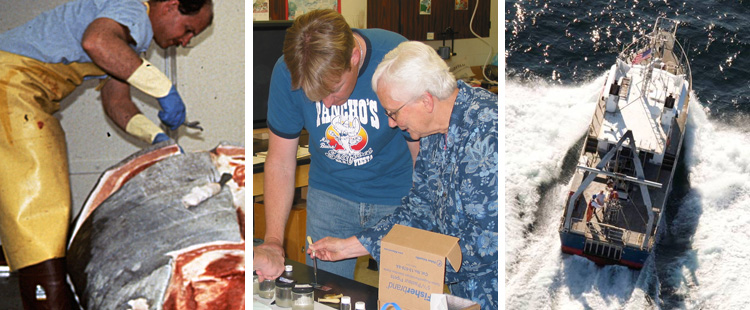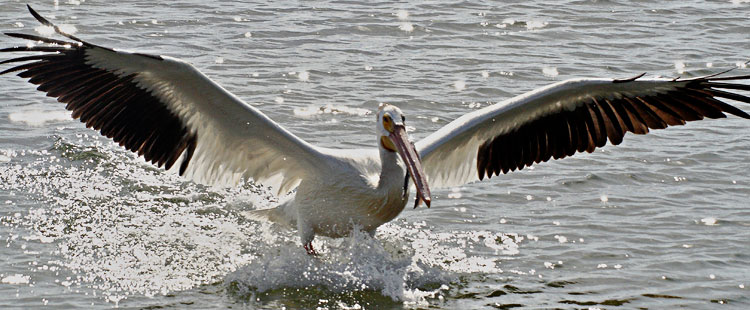Rapid Response

NCCOS's rapid response provides state and local coastal public health and resource managers with ready access to critical data on the types of HAB species and toxins present during a bloom event.
Every year many coastal states experience HABs that produce dangerous levels of natural toxins that force public health officials to close valuable commercial and recreational shellfish harvests and warn people away from popular bathing beaches. Toxic HABs are also a common threat to marine mammals, fish and seabirds, including endangered and threatened species, and often trigger costly rehabilitative actions and an outpouring of public concern. NCCOS maintains rapid response capabilities that help state and local coastal public health and resource managers have ready access to critical data on the types of HAB species and toxins that are present during a HAB event. The managers can then make informed decisions that mitigate the impacts of HABs on humans, coastal economies, and the environment. These capabilities include the Analytical Response Team and HAB Event Response Program. NCCOS coordinates the NOAA Analytical Response Team to provide rapid and accurate identification and quantification of marine algal toxins in suspected harmful algal blooms, marine animal mortality events, and human poisonings. The team is comprised of early event listeners, event assessors, and a team leader responsible of designing an event-specific solution. Responses are guided by the unique expertise and experience of the team rather than a pre-designed response. Our identification and analytical capability provides support for management agencies that can then make timely and informed decisions impacting stakeholders involved in coastal wildlife, human health, and commerce.
Analytical Response Team

Pelicans and other seabirds are susceptible to algal toxins concentrated in the fish they eat. NCCOS's Analytical Response Team figures out whether or not a large die-off of mammals, fish, or birds was caused by algae, and what that toxin is. (Photo credit: The U.S. Fish and Wildlife Service)
Harmful algal blooms (HABs) are increasingly recognized for their negative impacts on coastal ecosystems around the world. The natural toxins produced by various species of marine phytoplankton are the most common cause of marine mortality events involving marine mammals, fish and seabirds, and are a threat to human health. Confirmation of algal toxins has historically been elusive due to the complexity of toxin composition and challenges to quantifying the very low levels of toxins that can be lethal to marine wildlife. Managers of coastal resources need accurate information and need it in time to make informed decisions involving shellfish harvest, life support for marine wildlife, beach closures and remedial actions. The NOAA Analytical Response Team (ART) was established to provide a formal framework through which coastal managers may request immediate coordinated assistance during harmful algal blooms and related health incidents. ART acts as one of the primary responders to HABs and associated mortality events, providing rapid and accurate identification of harmful algae and their associated toxins. This identification and analytical capability provides support for management agencies that can then make timely and informed decisions impacting stakeholders involved in coastal wildlife, human health and commerce. ART is designed on the principals of a sense-and-respond unit. The team comprises early event listeners, a multidisciplinary team of event assessors from diverse scientific backgrounds, and a team leader responsible for designing an event-specific solution. Key to the success of the team is that the response is based upon the unique expertise and experience of each individual rather than a pre-designed response, and that all team members work together on a daily basis in a mission-based Program. This approach represents a revolutionary design in business in which "business is an adaptive system for responding to unanticipated requests in unpredictable environment".
Event Response Program

(Photo credit: Judy Kleindinst, Woods Hole Oceanographic Institution)
- Appearance of species, toxicity or harmful impacts that are unusual or unique for a particular U.S. coastal region and pose threats to public health and/or economically vital resources or which may lead to new discoveries in HAB science.
- Sudden or unexplained mortalities of seabirds, fish, or marine mammals for which a HAB linkage is suspected but which requires confirmation through additional sampling or observations.
- HAB events with major management or resource impacts for which additional data such as the size or extent of the outbreak, causative species, hydrographic characteristics of the associated water mass will be of use in subsequent management decisions.
How to Apply for NCCOS HAB Event Response Funding
- Scientists or management officials can initiate requests for assistance by contacting the Program managers (identified below).
- Program managers may consult NOAA colleagues, other members of the HAB community and the the U.S. National Office as necessary to determine a recommended course of action.
- If the potential for support is determined, the applicant will be asked to submit a brief, formal request to the designated Program Manager. A formal request should include the following:
- Description of the events/impacts and need for urgency
- Intended response plan
- CV for the Principal Investigator
- Listing of managers and researchers involved
- Explanation of assistance/support needed
- Brief budget and budget justification if funds are requested
- Requirements also include reporting to the designated Program manager: important preliminary results; completing a brief, written final report; acknowledging the Event Response Program in publications that result wholly or in part from NCCOS funding; and notifying the program about related publications.
Past HAB Event Response Efforts
Supported by the NCCOS Harmful Algal Blooms Event Response Program:
- NCCOS Assists Response to Harmful Algal Bloom in the San Francisco Bay (2022)
- NCCOS Funds Response to Marine Mammal Mortality Event Occurring in Southern California (2022)
- NCCOS Assists Response to Harmful Algal Bloom in the San Francisco Bay (2022)
- NCCOS Assists Response to Detect HABs in the Lower Chesapeake Bay (2022)
- NCCOS Assists Response to Quantify Toxin Accumulation in Seabirds and Prey Fish (2021)
- NCCOS Funding Supports Tribal Shellfish Toxin Testing in Southwest Alaska (2020)
- NCCOS Funds Investigation of Bioluminescent Red Tide Event Off Southern California Coast (2020)
- NCCOS Assists Response to Cyanobacterial Blooms in the Northern Gulf of Mexico (2019)
- NCCOS Assists Response to Multispecies Mortality Event Occurring in Norton Sound Region of Alaska (2019)
- NCCOS Assists Response to Cyanobacterial Blooms in Lake Pontchartrain Caused by Opening Bonnet Carre Spillway (2019)
- Exploring Airborne Health Risks from Cyanobacteria Blooms in Florida (2019)
- Florida Event Response Funding Helps Jump-Start Citizen Science Monitoring for Red Tide and Hypoxia (2018)
- NCCOS Event Response Examines Sea Turtle Mortalities and Dietary Exposure to Red Tide Toxins (2018)
- Funding Awarded to Study Airborne Health Risks from Cyanobacteria Blooms in Florida (2018)
- NOAA Funds Testing of Treatment for Birds Sickened by Florida Red Tide (2018)
- NCCOS Awards New Event Response Funding for Florida Red Tide (2018)
- NCCOS Helps Sitka Tribe of Alaska Respond to Harmful Algal Bloom (2018)
- NCCOS Responds to Southern California Harmful Algal Bloom Event (2017)
- Reducing Migratory Duck Mortality on Padre Island, TX (2017)
- NCCOS Helps Ohio Respond to Unusual Harmful Algal Bloom (2017)
- NCCOS Helps New England Respond to Unprecedented Harmful Algal Bloom (2017)
- NOAA Supports Florida’s Monitoring of Brown Tide in Indian River Lagoon (2016)
- NCCOS Supports Florida’s Martin County Assessment of Blue-green Algal Toxin Threat (2016)
- Investigating Diamondback Terrapin Die-Offs in New York (2015)
- Scientists Assess Impacts of Bioluminescent Algae on Chesapeake Bay Fisheries (2015)
- NCCOS Aids West Coast Partners Responding to Extensive Harmful Algal Bloom (2015)
- West Coast Harmful Algal Bloom Explained (2015)
- Additional Toxin Data Helped Ohio Deliver Safe Drinking Water After August Cyanobacteria Bloom (2014)
- Gliders Map Large Red Tide Bloom in Gulf of Mexico for Rapid Response (2014)
- NCCOS Aids Pennsylvania Response to First CyanoHAB in Presquie Isle Bay, Lake Erie (2013)
- NCCOS Responds to Harmful Algal Bloom Event Threatening Florida’s Indian River Lagoon (2013)
- Funds Issued to Aid Manatees Harmed by Red Tide (2013)
- NOAA Funds Response to Toxic Algal Bloom in Gulf of Maine (2012)
- Early Onset of Harmful Algal Bloom Leads to Long Island Shellfish Bed Closures (2012)
- Training in Shellfish Toxin Screening Provided to Alaska Community (2011)
Contact Information
For more information or to inquire about support, email the HAB Event Response Coordinator and Program Managers.
Sarah Pease, HAB Event Response Coordinator
Program Managers:
Marc Suddleson
Maggie Broadwater
Felix Martinez
 Official websites use .gov
A .gov website belongs to an official government organization in the United States.
Official websites use .gov
A .gov website belongs to an official government organization in the United States. Secure .gov websites use HTTPS
A lock or https:// means you’ve safely connected to the .gov website. Share sensitive information only on official, secure websites.
Secure .gov websites use HTTPS
A lock or https:// means you’ve safely connected to the .gov website. Share sensitive information only on official, secure websites. Register for one of three virtual public listening sessions for South Florida Clean Coastal Waters Act
Register for one of three virtual public listening sessions for South Florida Clean Coastal Waters Act